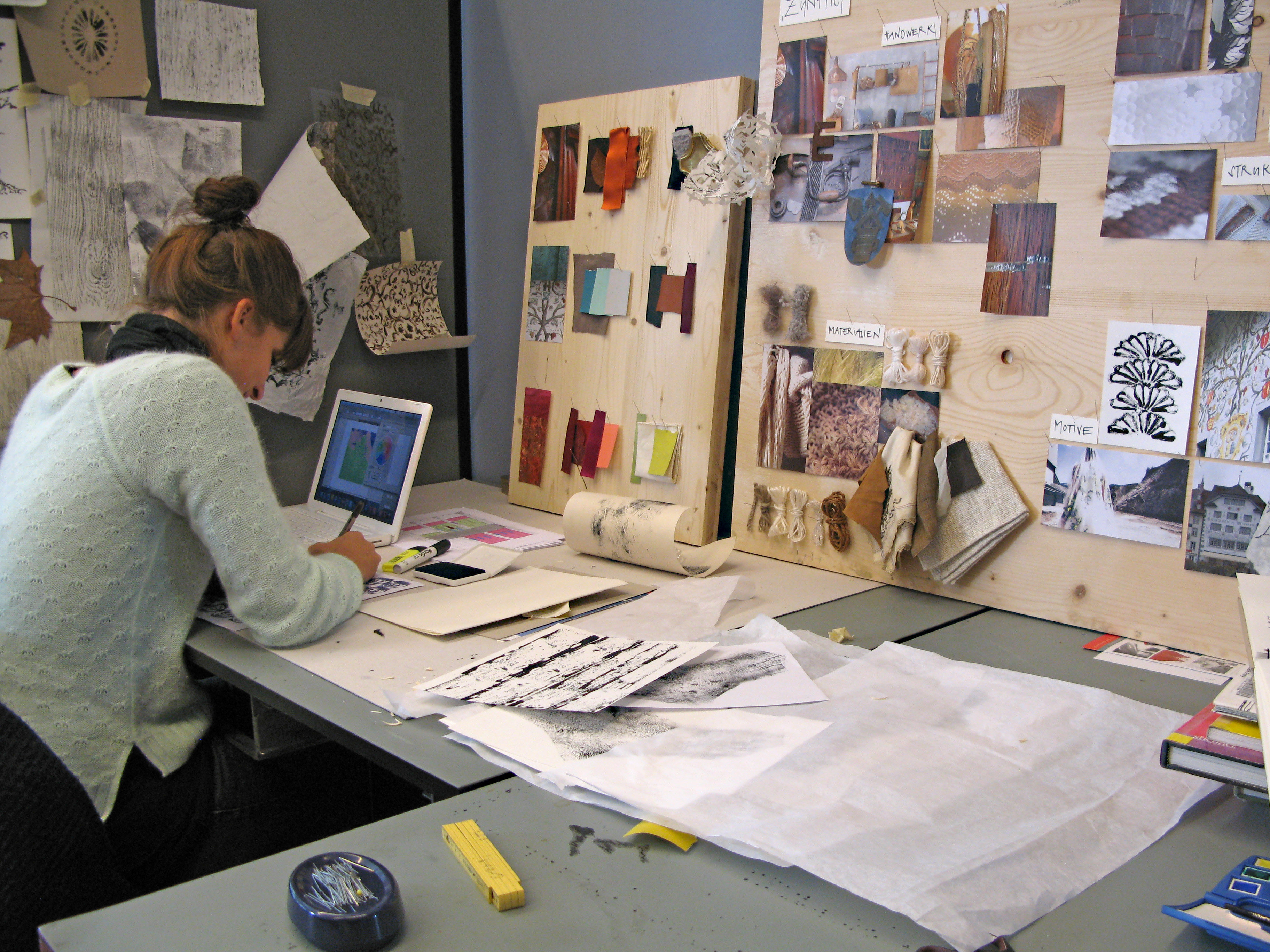Future designers fashion fabric of their dreams

The tables and floor are covered with sketches, photos, fabric scraps, twisted wire, and unidentifiable bits of flotsam and jetsam. They’re meant to serve as the inspiration for yet-to-be-born textiles.
“It should be a fun process; you should enjoy coming up with a collection. That’s ‘Gestaltung’ – adding something and taking something away,” lecturer Isabel Rosa Müggler reminds the students, some of whom knit their brows as they contemplate ideas for knitwear.
Her charges are in their third and final year of the bachelor programme for textile design at Lucerne University, the only such course in Switzerland.
It’s an hour’s drive – and a world away – from the glam of the Zurich Fashion Days happening in November. On the day swissinfo.ch visited Lucerne, the future designers were gathered for a session on collection building.
Each had spent a couple of weeks coming up with countless sketches and other impressions based on a basic object like a teacup or a coat hanger. Carmen Boog selected a bicycle handlebar grip.
“I didn’t know what it was at first, but I had some ideas of what to do with it,” recalls Boog, who started off using it like a rubber ink stamp. Then she smeared the ink, drawing lines through the thick black circles. That led to delicate sketches of flowers, including a cut-out version in bright orange.
“For this project you could only move forward from the last design you did – you weren’t allowed to go back to a previous element; that was a bit complicated,” notes Boog, who ended up with well over 100 works.
She then had to select just a fraction of them to create the basis of two potential collections of textile concepts. After that, she and her classmates did the same for each other – lending that critical outside eye. Finally, they created combinations merging their work with that of their colleagues.
Making things
Yet theory is just a part of the course.
“For us, it’s really important to make things. We learn by doing, so we weave to find out ‘How does it look? How does it feel?’,” explains Tina Moor, head of the textile design programme. In addition to weaving, the students learn embroidery, printing and knitting techniques.
“There’s a language for every technique. They won’t be producing the textiles themselves, but they’ll have to be able to speak with the technicians who are,” Moor says.
Down the hall from Moor’s office, two first-year students spend their lunch break getting the hang of the knitting machines – fussy-looking objects with fine yarn stretching out in all directions. (The journalist, fascinated by the process, nearly trips over the large spools on the floor.)
“It’s my second day using this machine so there’s a lot to learn, but it’s not impossible,” Marta Alfaro says. “Right now we have to combine two colours to create a jacquard [weave].”
Her classmate, Carmina Ibanez, has chosen red and green, joking that she wanted to use the colours of the Mexican flag. “They’re not my favourite colours together, but when you’re starting out it doesn’t matter. The important thing is that you learn the technique,” Ibanez explains.
Interdisciplinary aspect
To expand their horizons, the textile design students sometimes collaborate with peers from other departments at Lucerne University.
The second-year students are cooperating with the local historical museum as well as a nearby architectural school. For that project, the theme is innovation and tradition; the idea is to revive the memory of Lucerne’s forgotten handicrafts.
Second-year student Cornelia Stahl has chosen to focus on the guilds.
“First I made a list of everything that interested me, and then I looked for inspirational images for my mood board. I searched for materials, motifs, structures and handicrafts that would work with the theme. And from there I came up with the colours,” says Stahl while pointing at her attractive domain in the school’s atelier.
Every student gets a partitioned workspace where she can dream up ideas for new textiles. Each class has room for 16-18 students, nearly all of whom are female. (Moor says that the men in the industry tend to work in production, but that she would like to see more on the design side.)
Stahl appreciates the variety offered by her chosen career.
“Fabric has always interested me and what I find especially exciting is that it can apply to fashion as well as interior design – it’s not limited to just one area,” Stahl says.
Future prospects
There are certainly opportunities for fresh talent in Switzerland, according to Nathalie Riggenbach, the spokeswoman for the Swiss Textile Federation.
“We have some great companies, such as Schoeller Textile or Creation Baumann, who are very strong in new innovations. They always need young designers. Both the Swiss Textile Federation and the companies themselves are working hard to get good young designers,” Riggenbach told swissinfo.ch.
However, there are more jobs abroad, points out Annina Weber, who graduated from Lucerne’s textile programme in 2007.
“In Switzerland the selection is small. I did an apprenticeship in Antwerp with Christian Wijnants, who won the Swiss Textiles Award in 2005,” said Weber, who now works in St Gallen as a textile designer for Christian Fischbacher, a company that makes bedding, towels, carpets and other interior fabrics. Her other employer is the Swiss Textiles Museum, also in St Gallen.
Some of the students in Lucerne turned to textiles after learning another trade. For example, third year student Annina Frey studied dressmaking before making the switch to textile design.
“I always wanted to work with clothing and textiles, but dressmaking is really strict. Here you can be more creative,” Frey says.
According to Moor, the most important thing is creativity. “You always have to have ideas,” she says, and as long as you do, “it’s the best job”.
The Mercedes-Benz Fashion Days Zurich run from November 7-10, 2012. It is a ticketed event open to the general public.
Highlights include fashion shows with a variety of Swiss and international designers such as Barbara Bui of Paris and Charlotte Ronson of New York. Design awards and concerts round out the programme.
The decline in exports of the Swiss textile and garments industry slowed in 2011, but exports were 5.2% lower by comparison with the previous year at SFr2.99 billion ($3.2 billion). Imports were 1.1% lower at SFr7.59 billion. The flatter decline in trade brought an increase in “added value” in 2011 by comparison with the previous year of 1.4% to SFr1.19 billion.
Source: Swiss Textile Federation
Previously, Zurich only had a fashion night, and this was held in connection with the Swiss Textiles Award.
From 2000 to 2010, the Swiss Textile Federation promoted young designers via the award – which was essentially a voucher for thousands of francs’ worth of Swiss fabric.
Recent winners include Britain’s Mary Katrantzou and Alexander Wang of the US.
Today the federation has the Golden Velvet Award, which honours young filmmakers who have captured Swiss textile innovation on film. The prize will be awarded in Zurich on November 15, 2012.

In compliance with the JTI standards
More: SWI swissinfo.ch certified by the Journalism Trust Initiative













You can find an overview of ongoing debates with our journalists here . Please join us!
If you want to start a conversation about a topic raised in this article or want to report factual errors, email us at english@swissinfo.ch.